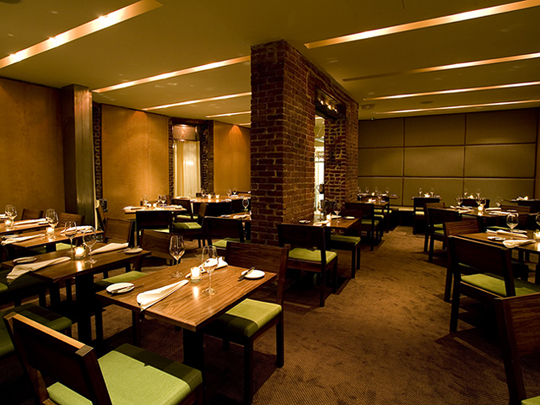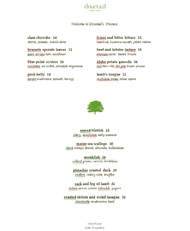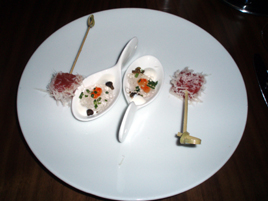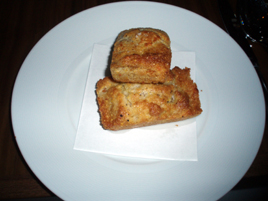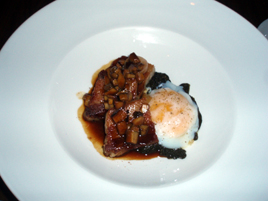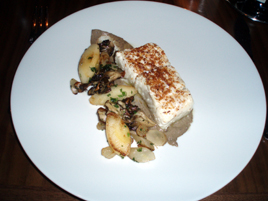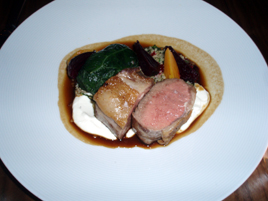
Note: What Happens When closed in June 2011, after five months. It had intended to remain open for nine months, but could no longer continue after it lost its liquor license. With sufficient effort it probably could have been reinstated, but for a restaurant that had planned to close anyway in October it wasn’t worth the expense.
*
 Just one word . . . pop-up. It seems to be the latest restaurant trendlet. Exactly where the term originated is beyond google’s capacity to answer, but you don’t find many references before 2010.
Just one word . . . pop-up. It seems to be the latest restaurant trendlet. Exactly where the term originated is beyond google’s capacity to answer, but you don’t find many references before 2010.
 The notion of a “pop-up restaurant” is somewhat elastic. It can take many different forms. The one clear requirement is planned extinction: these places aren’t meant to last. Some exist for just a night or two.
The notion of a “pop-up restaurant” is somewhat elastic. It can take many different forms. The one clear requirement is planned extinction: these places aren’t meant to last. Some exist for just a night or two.
Then, there’s John Fraser’s new pop-up, What Happens When — though he prefers the term “temporary restaurant installation” — which he insists will die after nine months, if not sooner.
Fraser is best known as chef of the Michelin-starred Dovetail on the Upper West Side, which is still doing fine. My two meals there (here, here) were slightly meh, although I liked his work at Compass.
So what is Fraser doing in a restaurant that he’ll kill after nine months? As he told Frank Bruni:
He was wondering what it might be like to have a restaurant he could fool around with and walk away from when, less than three months ago, he happened upon the SoHo space, on Cleveland Place, where Le Jardin Bistro had just closed. The landlord was willing to write an eight-month lease, beginning in December, with a likelihood of several month-by-month renewals until the building, mostly vacant, can be redeveloped.
 What Happens When is not so much a pop-up, as a string of them. Once a month, the menu, the décor, and the soundtrack will be tossed out and re-done. The current version looks just as temporary as it was meant to be, but it’s nicer and more polished than many restaurants I could name that don’t have sell-by dates.
What Happens When is not so much a pop-up, as a string of them. Once a month, the menu, the décor, and the soundtrack will be tossed out and re-done. The current version looks just as temporary as it was meant to be, but it’s nicer and more polished than many restaurants I could name that don’t have sell-by dates.
Part of the funding is coming from Kickstarter, a creative arts seed money site. This is an unusual approach, as restaurants, pop-up or otherwise, are practically always treated as profit-seeking ventures. It makes you wonder what would be possible, if the culinary arts were more often funded like the rest of the arts, with donated money?
Mind you, he’s not giving the food away. The menu is $58 prix fixe. After three cocktails ($13 each) and coffee ($5), the bill came to $102 before tax and tip. That’s a fair price for food that would have a good shot at three New York Times stars if the restaurant were permanent. Of course, if the restaurant survives for the full nine months, he’ll need to come up with eight more menus as good as this one.
 Fraser has a graphic artist, an interior designer, and a composer on his team, for what he calls “an ever-changing culinary, visual, and sound experience.”
Fraser has a graphic artist, an interior designer, and a composer on his team, for what he calls “an ever-changing culinary, visual, and sound experience.”
Your eyes may glaze over when you see all of the hand-doodled drawings explaining the “inspiration” for what’s called “Menu No. 1”: blue cold conflict expectation ice intensity reflection tension Winter.
There’s a faintly wintry feel to the current menu, but if there is any reflection or tension in the offerings, the connection entirely eluded me.
The menu is brief (just four appetizers and five entrées), and so are the wine and cocktail lists, also suffixed with “No. 1.” The current cocktail list offers three creations, all named for characters in Hamlet: Polonius (gin, mandarin orange juice, sweet & dry vermouth), Ophelia (photo below; vodka, dry vermouth, pickling liquid), and Laertes (rum, allspice, lime, honey). Again, how these related to the “inspiration” wasn’t quite clear, but they did pair well with the food.


The meal began with a trio of amuses bouches (above right): from right to left, a bracing pea soup, an onion dip with croutons and pickled ramps, and “ants on a log,” served with a champagne cocktail.


The bread service (above left) is wonderful here, as it always is at Fraser’s restaurants: a warm garlic–olive oil roll with a hint of cheese and black pepper.
The appetizer (above right), referred to as “potato skins” on the menu, is much more elaborate than that. Hollowed-out fingerling potato skins join forces with pickled sausage, sorrel, and a wheat beer fondue.


I was comped an excellent spiced foie gras and rabbit terrine (above left). (It’s not listed on the menu, and I didn’t see it at any other tables.)
The guinea hen entrée (above right) had many supporting players, and I can’t do justice to all of them. I especially liked the buckwheat crèpe (left side of the plate). The breast of guinea hen itself was just a shade less tender than it should have been, but the conception of the dish was first-rate.
Desserts came around on a cart, a startlingly old-school idea at an anything-but-old restaurant. The menu doesn’t credit a separate pastry chef, and the desserts (three of them, I think) didn’t quite have as much inspiration as the savory courses. I had the rice pudding, which was just fine, but you could have it anywhere.
There are some obvious compromises at What Happens When. Fraser told Frank Bruni that it cost about $100,000 to build, as opposed to over $2 million at Dovetail. The chairs supposedly came from eBay, though I’d take them any day over the backless bar stools that you have to endure at the Momofuku restaurants.
He certainly hasn’t skimped on service. I saw a small platoon of chefs behind the half-open kitchen window, and there are certainly enough servers for the 65-seat room. The tables have small silverware drawers, and you’re encouraged to lay the table yourself, but after the first course the staff replaced the silverware, as they would at any other restaurant.
Reservations are accepted through the nascent Urbanspoon online site, instead of the more established (but far more expensive) OpenTable. Availability most days is typical of a hit restaurant in New York City: 5:30 or after 10:00. If What Happens When wasn’t temporary, you’d have to ask if that could last? At a restaurant that is expected to be gone in nine months, the question doesn’t matter.
Why nine months? Fraser told Bruni that even if the building remained available, What Happens Next wouldn’t continue: beyond that, it would become another permanent restaurant, negating the whole point of a venture that you can play with, and then dispose of. But if it works, it’s hard to believe that someone else, if not Fraser himself, will try the same thing again.
The current menu will be in place until February 25.
What Happens Next (25 Cleveland Place between Kenmare & Spring Streets, Soho)
 Monday, May 5, 2014 at 08:17PM
Monday, May 5, 2014 at 08:17PM 
 You have to admire the effort behind Narcissa, chef John Fraser’s new restaurant in The Standard East Village hotel. The space is lovely, and well put-together. But we’ve been down this road before, and it usually doesn’t end well.
You have to admire the effort behind Narcissa, chef John Fraser’s new restaurant in The Standard East Village hotel. The space is lovely, and well put-together. But we’ve been down this road before, and it usually doesn’t end well. For the main restaurant (there is also a casual café), Balzacs followed a formula that has already bombed here twice, bringing in a respected chef who could fill seats on name recognition alone. First it was Govind Armstrong at Table 8, then Scott Conant at Faustina. Now it’s John Fraser, whose quiet Upper West Side restaurant Dovetail has a Michelin star. Let’s hope they have better luck this time.
For the main restaurant (there is also a casual café), Balzacs followed a formula that has already bombed here twice, bringing in a respected chef who could fill seats on name recognition alone. First it was Govind Armstrong at Table 8, then Scott Conant at Faustina. Now it’s John Fraser, whose quiet Upper West Side restaurant Dovetail has a Michelin star. Let’s hope they have better luck this time.































